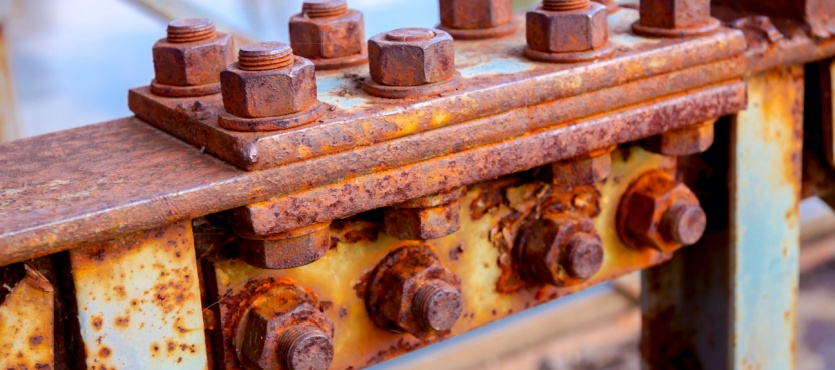Rust might seem like a minor nuisance, but its effects on machinery, infrastructure, and operational efficiency can have significant financial repercussions. Corrosion doesn’t just affect the appearance of equipment; it compromises functionality, safety, and overall productivity. For businesses relying on machinery and equipment, understanding the hidden costs of rust is essential to safeguard profitability and ensure smooth operations.
Reduced Equipment Efficiency
One of the first impacts of rust is reduced efficiency. When metal parts corrode, their structural integrity weakens, leading to increased friction and diminished performance. For example, rusted moving parts in machinery require more energy to function, leading to higher energy consumption. Over time, this inefficiency accumulates, driving up operational costs.
Moreover, rust can interfere with precision in equipment like HVAC systems or manufacturing tools, compromising the quality of products and services. The additional energy costs and loss in productivity caused by inefficiency directly affect a company’s bottom line.
Increased Maintenance and Repair Costs
Rust accelerates wear and tear on equipment, leading to frequent maintenance and costly repairs. Components damaged by corrosion often require replacement sooner than expected, putting an additional strain on maintenance budgets. For businesses with large fleets or complex machinery, these costs can add up significantly.
In many cases, rust damage may not be visible until it causes a malfunction. Emergency repairs to address rust-related issues are often more expensive than routine maintenance, creating unplanned financial burdens. Proactive rust prevention and regular inspections can mitigate these risks, saving money in the long run.
Shortened Equipment Lifespan
Corrosion significantly shortens the lifespan of machinery and infrastructure. A piece of equipment that could have lasted 20 years might need to be replaced in 10 due to extensive rust damage. This premature depreciation of assets forces businesses to invest in new equipment more frequently, diverting funds that could be used for growth or innovation.
Rust prevention measures, such as applying protective coatings or conducting regular rust removal, can extend the operational life of equipment. Businesses that prioritize these measures reduce the frequency of replacements, thereby lowering capital expenditures over time.
Operational Downtime
Rusted equipment is more prone to unexpected breakdowns, leading to costly operational downtime. For industries that rely on continuous production, such as manufacturing, logistics, or construction, downtime disrupts workflows, delays projects, and affects customer satisfaction. The financial losses incurred during these interruptions can be staggering.
Preventive rust management helps minimize the likelihood of equipment failure. By addressing corrosion early, businesses can avoid disruptions and maintain consistent operations. The reduced downtime also contributes to better client relationships and on-time project delivery, protecting revenue streams.
Safety Hazards and Liability Risks
Rust compromises the structural integrity of equipment and infrastructure, increasing the risk of accidents and injuries. For example, a rusted HVAC system could develop leaks, leading to poor air quality, while corroded industrial machinery might fail during operation, endangering workers.
Accidents caused by rust-related issues can lead to expensive legal liabilities, workers’ compensation claims, and damage to a company’s reputation. Investing in rust prevention ensures safer working conditions, reduces liability risks, and helps businesses avoid the financial fallout of workplace accidents.
Environmental Impact and Fines
In industries where rusted equipment causes leaks or releases harmful substances, companies may face environmental fines and cleanup costs. Corrosion in pipelines, storage tanks, or chemical handling systems can result in spillage that harms the environment, leading to regulatory penalties and reputational damage.
Rust prevention and regular maintenance not only protect equipment but also demonstrate a commitment to environmental responsibility. Businesses that prioritize sustainability and compliance benefit from improved public perception and avoid costly penalties.
Hidden Energy Costs
Corroded equipment often requires more energy to function due to increased resistance and friction in moving parts. This inefficiency directly affects energy bills, especially for large-scale operations where multiple machines are in use. Over time, the increased energy consumption caused by rust-related inefficiency can significantly impact a company’s financial performance.
By addressing rust early and implementing preventive measures, businesses can maintain the efficiency of their equipment, resulting in lower energy costs and a reduced carbon footprint.
Long-Term Reputation Damage
Beyond the immediate financial costs, rust can damage a company’s reputation. Equipment failures caused by corrosion can lead to missed deadlines, poor-quality products, or subpar service delivery. Customers and clients who experience these issues may lose trust in the company and seek alternatives, resulting in lost revenue and long-term reputational harm.
Proactive rust management ensures reliability and consistency, which are essential for building customer loyalty and securing repeat business. Companies that invest in maintaining high standards are more likely to thrive in competitive markets.
Protect Your Bottom Line by Preventing Rust
Rust may seem like a minor issue, but its hidden costs can have a far-reaching impact on your business’s bottom line. From increased maintenance expenses and shortened equipment lifespans to operational downtime and safety risks, the financial repercussions of corrosion are significant. Investing in rust prevention measures, such as protective coatings, regular inspections, and professional rust removal, is a cost-effective strategy to safeguard your assets and ensure long-term profitability.
For expert rust prevention and removal solutions, visit RustyGone. Our team is dedicated to helping businesses protect their investments and maintain efficient, reliable operations.

